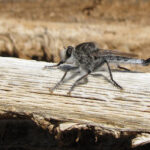Kissing bugs, also known as Triatomine bugs, are nocturnal insects notorious for their blood-feeding habits, often targeting humans around the mouth area while they sleep – hence the name “kissing bugs.” Primarily found in the Southern and Western United States, Mexico, and parts of Central and South America, these bugs have raised concerns due to their potential to transmit Chagas disease. A common question arising among those living in or traveling to these regions is: Does Kissing Bug Fly? Understanding their flight capabilities is crucial for assessing risks and taking appropriate preventative measures.
What are Kissing Bugs?
Kissing bugs are identified as various species within the Triatominae subfamily. In the United States, there are 11 recognized species. Institutions like Texas A&M University, through their Kissing Bugs & Chagas Disease in the United States Community Science Program, actively identify specimens, noting Texas, New Mexico, and Arizona as states with higher prevalence and species diversity. These insects are typically medium-sized, with a cone-shaped head and often featuring distinctive markings. They are primarily active at night, seeking out blood meals from mammals, including humans, birds, and other animals.
Do Kissing Bugs Fly? Unveiling Their Flight Capabilities
Yes, kissing bugs are indeed capable of flight. They possess wings and can fly, although they are not considered strong or agile fliers like some other insects. Their flight is generally described as clumsy and short-ranged. This flight ability, however, is significant for several reasons:
- Dispersal: Flight allows kissing bugs to disperse and colonize new areas. This is how they can move from wild animal habitats to human dwellings.
- Attraction to Lights: Kissing bugs are attracted to lights at night. This phototaxis, or movement towards light, can lead them into homes through open doors or windows, especially in the evening.
- Host Seeking: While they may not fly long distances to find a host, flight can assist them in moving within a local area to locate a blood meal source.
Therefore, while they might not soar through the sky, their ability to fly short distances is a key factor in their life cycle and their interaction with humans.
Chagas Disease: Understanding the Real Threat
Kissing bugs themselves are not inherently dangerous in terms of venom or a painful bite. The primary concern stems from their potential to carry Trypanosoma cruzi, a parasite that can cause Chagas disease, also known as American trypanosomiasis. Approximately 50% of kissing bugs in the U.S. are estimated to be infected with this parasite.
Transmission of Trypanosoma cruzi to humans typically occurs when an infected kissing bug defecates after feeding on blood. If the person scratches the bite area, the parasite-containing feces can be rubbed into the bite wound, eyes, nose, or mouth, leading to infection. This is the most common route of transmission.
Although Chagas disease is rare in the U.S., it’s crucial to be aware of the risks, especially in endemic regions. Untreated Chagas disease can lead to severe and potentially life-threatening complications, particularly affecting the heart and gastrointestinal system. These complications can include:
- Cardiac Issues: Enlarged heart (cardiomegaly), heart failure, irregular heart rhythms, and sudden cardiac arrest.
- Gastrointestinal Problems: Enlarged esophagus (megaesophagus) or colon (megacolon), causing difficulties in swallowing and bowel movements.
Children and individuals with compromised immune systems are at higher risk of severe Chagas disease outcomes.
Prevention and Protection Strategies
Given that kissing bugs can fly and are attracted to lights, and considering the risk of Chagas disease, taking preventive measures is essential:
- Seal Entry Points: Seal cracks and gaps in walls, roofs, windows, and doors to prevent bugs from entering homes.
- Screen Windows and Doors: Ensure windows and doors have screens in good repair to keep insects out.
- Outdoor Lighting Management: Reduce outdoor lighting, especially near dwellings, as lights attract kissing bugs. If outdoor lighting is necessary, use yellow or sodium vapor lights, which are less attractive to insects.
- Clear Outdoor Areas: Remove brush, wood piles, and rock piles near homes, as these can serve as habitats for kissing bugs and their animal hosts.
- Pet Bedding and Housing: Keep pet bedding clean and away from bedrooms. Consider moving outdoor pet housing away from the house.
- Inspect and Clean Indoor Areas: Regularly inspect and clean areas where pets sleep and other potential hiding spots indoors.
- Use Insecticides (Carefully): If necessary, use insecticides labeled for crawling insects around potential entry points and outdoor harborage areas, following label instructions carefully.
- Protective Measures While Sleeping Outdoors: When sleeping outdoors in endemic areas, use bed nets treated with insecticide.
Conclusion: Awareness and Vigilance
Understanding that kissing bugs do fly, even if not powerfully, is a critical piece of knowledge for residents and travelers in affected areas. Their flight capability contributes to their dispersal, attraction to homes, and host-seeking behaviors. While Chagas disease remains relatively rare in the U.S., the potential health risks associated with Trypanosoma cruzi transmission are significant. By implementing preventive measures and being vigilant about potential kissing bug presence, individuals can significantly reduce their risk of exposure and infection. Awareness and proactive steps are key to coexisting safely with kissing bugs in regions where they are prevalent.
